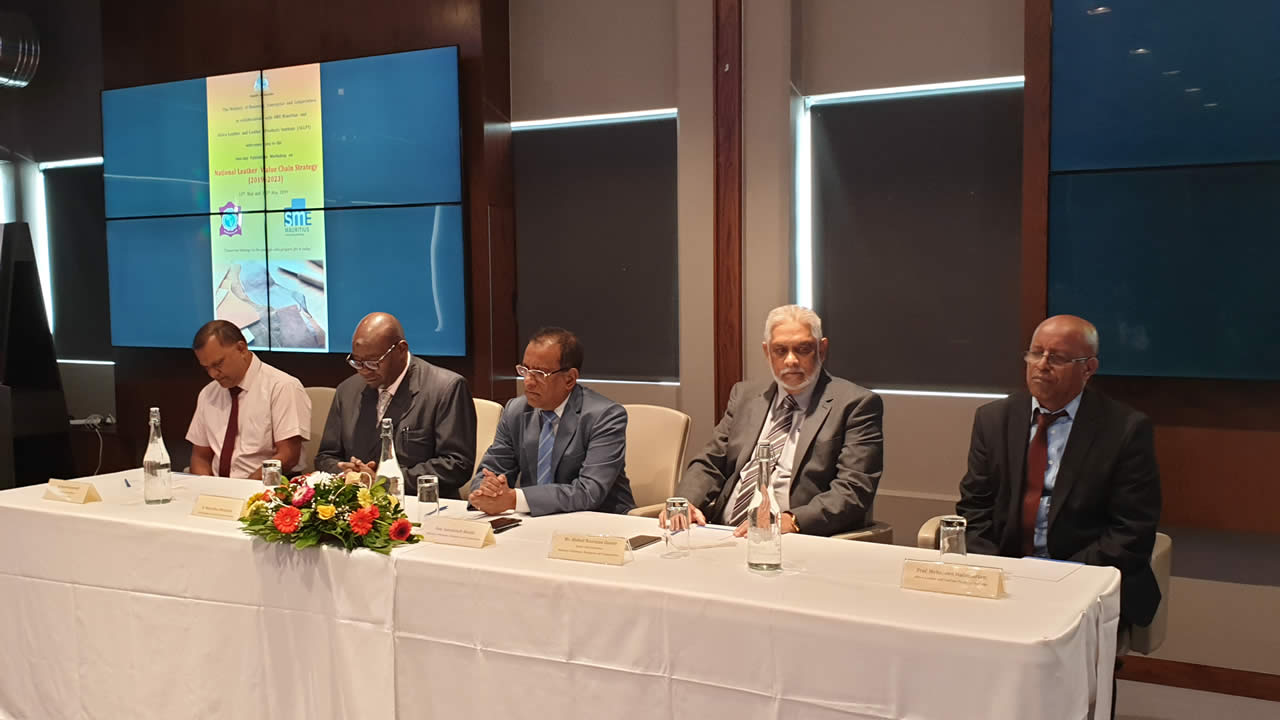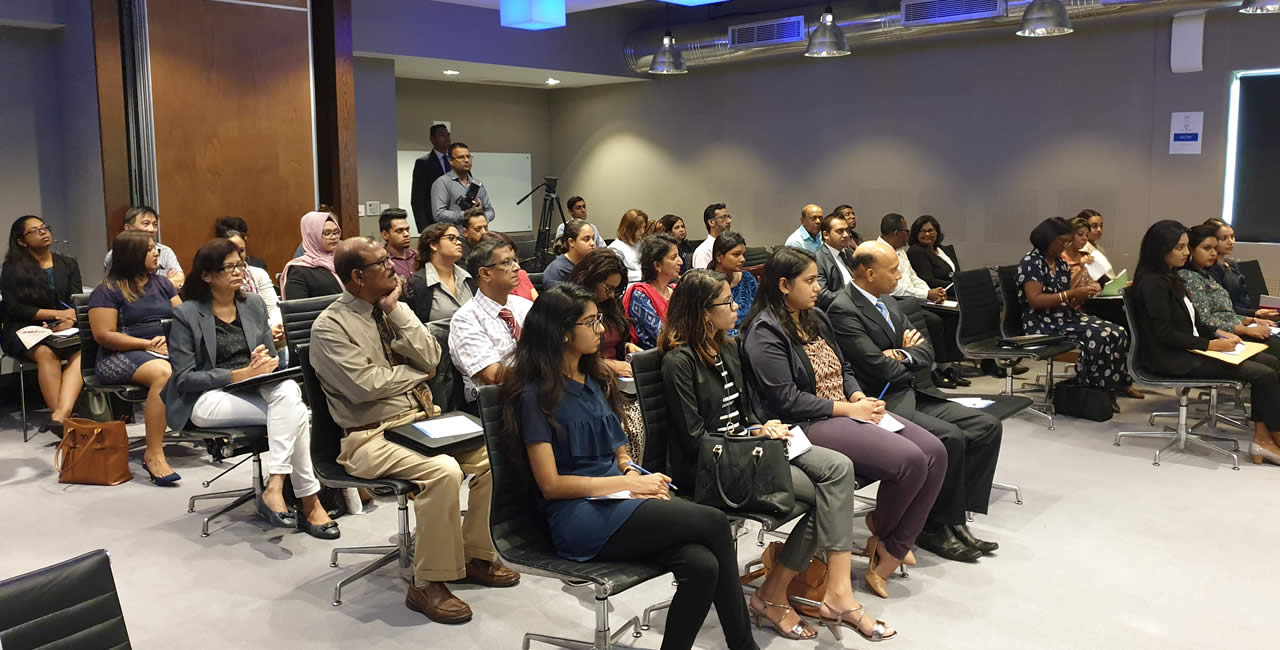
The launching of a National Leather Value Chain Strategy by the Minister of Business Soomilduth Bholah took place on Wednesday 15th May at Voilà Hotel, Bagatelle. Prepared by consultants from the Africa Leather and Leather Products Institute (ALLPI), COMESA in collaboration with SME Mauritius, this strategy aims to give a new makeover to the leather sector in the country.
A first in Mauritius, a National Leather Value Chain Strategy was launched this week by the Minister of Business, Soomilduth Bholah, in the presence of other stakeholders, namely the Chief Executive Officer of SME Mauritius Ravin Rampersad, Dr Mwinyihija Mwinyihija and Professor Mekonnen Hailemariam, both from the Africa Leather and Leather Products Institute.
In his speech, Minister Bholah stated that the African leather sector is bursting with potential but that there is a wide gap between resources and production. “Reducing the gap is critical as a leather industry strategy for economy and industrial development helps to boost exports in the entire continent. Leather is also a labour intensive industry and is an important source of employment along with its supply. Africa can be both a source of raw materials and an exporter of finished products. I am thus convinced that institutions such as ALLPI can be of great assistance in identifying challenges and formulating appropriate support mechanisms to allow African countries to size global markets opportunities.”

The Minister underlined that over the years, the leather sector in Mauritius has shown signs of contractions in the number of enterprises and employment rates. However, he trusts that with the leather industry being a lucrative one, it can bring considerable gains to the country. Soomilduth Bholah added that a national strategy will serve as a guide for designing policies instruments and activities to support different players in the leather supply chains. “Our objective is to revamp and revitalise the Mauritian leather sector so as to undertake the quantum leap to enter niche markets, and to explore potentials to establish high end finished line leather products with the application of modern technologies.” He highlighted that according to the statistics for year 2016 and 2017, Mauritius exported a total 377million and 407million of leather products respectively which he qualified as great loss of economic opportunities for local entrepreneurs.
For his part, Rabin Rampersad underscored that SME Mauritius Ltd as a key stakeholder is at the forefront of several initiatives being taken in different sectors namely in handicraft, aquaponics and leather. The organisation, he emphasised, is engaged in the dissemination of technical knowledge and expertise as well as providing financial support to entrepreneurs especially those who are commercialising their businesses.
Create a niche market
Dr Mwinyihija Mwinyihija shares that the Institute had the dream to look into the potential of countries where it could move with them to develop the SMEs and address critical issues of the economy such as youth engagement, employment, wealth creation, reducing poverty and pushing the industrialisation pillar. “For us to do that, we had to come to Mauritius and do a baseline survey where we looked at the actual realistic scenario of how things are. When we came here three years ago, we were surprised to notice that Mauritius had a solid baseline that could be explored for the betterment of the youth. We also found that the gender parity issues were already being tackled. So, we just joined the board and gave a few ideas of how we can sail together to attain some fusion.” He underlined that their aim is to see to it that the policy framework will open all different avenues that will pave the path to tackle a diversity of issues.
“We had very strong support from the Government and the various stakeholders. It has thus been an easy path for us to implement some of the issues. This is a unique policy which is sectorial based for the leather sector. The next step is that we will be looking at issues of capacity building where we are going to build skills, particularly for the youth. Later, we are going to look at what type of niche can Mauritius build for itself in the leather sector in Africa, so that it can address some of the big gaps that exist and also, we are looking at how the products can have a local Mauritian identity with the intent of marketing both locally and globally. The policy is thus the driving framework that is going to take us to the next level,” uttered Dr Mwinyihija.

He explained that the policy framework will help to identify the strengths, weaknesses which need to be looked into, the threats as well as the opportunities. “We have developed a strategic framework which tells us exactly how to move through each objective. Following the launching of the strategic plan, the participants of the two-day workshop broke the objectives into activities which were then allocated to individual ministries, people, among others, so that we become your partner in Mauritius as long as we are going to be implementing the leather sector.”
When it comes to the potentials of the development of the leather industry in Mauritius, Dr Mwinyihija highlights that Mauritius has very strong ICT based enterprises. “We have never utilised that in the leather sector. The demand for ICT to support the leather sector is strong and one of the areas that Mauritius can actually create a niche for itself is the designing aspect. We want the designing of leather products to have a home. Then Mauritius also has its youth who want to get involved and who are interested in ICT related issues. We want to bring them in so that they can use the potential underlying to come up with products. We desire to re-sparkle the interest in the leather sector because one of the biggest problems in Africa is that we have never made the leather sector attractive to the youth,” he trusts.
He states that they are not only looking at leather products per se but also other products that can blend with leather. “The Mauritian people are very creative. Blending factors such as designing and creativity will definitely yield products that are going to be fantastic. Our work will only be to direct the leather Mauritian products to the global markets. Within a few years, people would be talking about leather products from Mauritius.”
Dr Mwinyihija revealed that a Task Force will be monitoring the work achieved within the time frames.
The National Leather Value Chain Strategy has seven major objectives, among to improve the quality and collection of raw hides and skins, facilitate the production of quality finished leather in an environmentally friendly manner, enhance value addition and SMEs competitiveness in domestic, regional and international markets, enhance youth interest and customer satisfaction through ICT application in footwear industries, among others.








